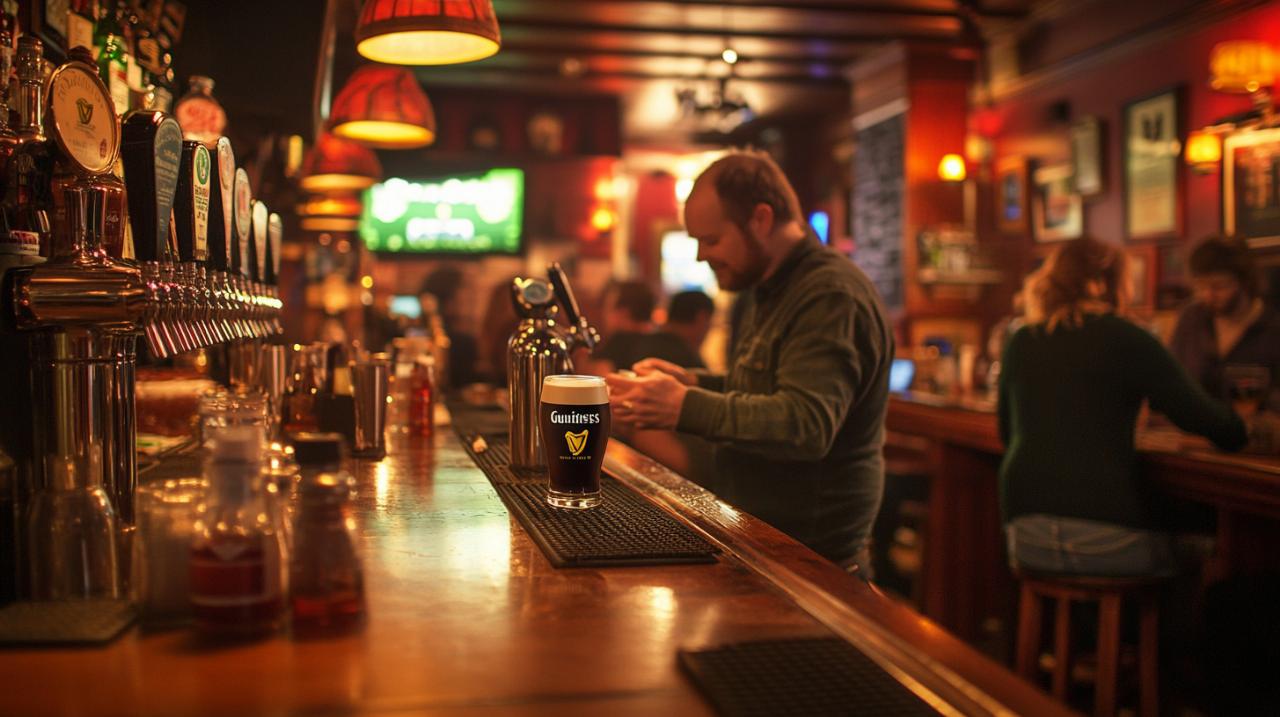The Heritage of the Black Stuff: Arthur Guinness and the Dublin Brewery
When discussing the iconic beverage that has become synonymous with Ireland itself, one must begin with the story behind the legendary stout. In 1759, Arthur Guinness signed what might be the most audacious lease in business history – securing the St. James's Gate Brewery in Dublin for 9,000 years at just 45 pounds annually. This bold move would lay the foundation for what would become not just a beer, but a global cultural phenomenon. Today, Guinness is brewed in 48 countries worldwide, with an estimated 10 million pints consumed daily across the globe. Yet despite this massive scale, many beer enthusiasts insist that Guinness tastes better in Ireland, particularly in Dublin, close to where the brewing magic began.
From arthur's vision to global phenomenon: the guinness legacy
What started as a local Dublin brewery has transformed into one of the most recognised brands in the world of beer. The legacy of Guinness extends far beyond just the dark stout in your glass. The company's innovation in brewing techniques, particularly its pioneering use of nitrogen in draught systems, revolutionised how stouts are served globally. The original recipe for this iconic stout remains largely unchanged, though beer taste variations have been noted depending on where you drink it. Some experts suggest that the bitterness profile can increase the further the product travels from Dublin, potentially explaining why many believe the taste is superior on Irish soil. This connection between brewing locations and taste perception has fascinated beer enthusiasts and researchers alike.
Inside the storehouse: dublin's beer pilgrimage
The Guinness Storehouse in Dublin has become something of a mecca for beer lovers around the world. Standing at the heart of the St. James's Gate Brewery, this seven-storey visitor experience offers insights into the brewing process, the brand's history, and culminates with a pint in the Gravity Bar overlooking the city. According to Colm O'Connor from the Guinness Storehouse, the quality begins with sourcing – the barley used in Dublin-brewed Guinness comes from within 80 miles of the brewery, potentially contributing to that distinctive taste that has made it famous. The Storehouse experience itself contributes to the mystique surrounding Guinness, creating an emotional connection between visitors and the brand that may enhance their perception of taste when they finally sip that perfectly poured pint.
The science in your glass: what makes guinness unique
Beyond heritage and tradition, there are scientific elements that make Guinness stand out from other beers. The distinctive cascade effect as the beer settles, creating that iconic creamy head, isn't just visually appealing – it fundamentally alters how the beer delivers flavour to your palate. This distinctive quality has helped Guinness maintain its position even as craft beer trends have transformed the industry around it. Many breweries have attempted to replicate the distinctive character of Guinness, but few have managed to capture its unique combination of roasted barley notes, velvety texture, and visual drama.
Nitrogen vs Carbon Dioxide: The Secret to that Creamy Head
The magic of Guinness lies partly in its gas composition. Unlike most beers which use carbon dioxide alone, Guinness employs a mixture of nitrogen and carbon dioxide. This combination creates smaller bubbles, resulting in the creamy texture and long-lasting head that defines the stout pouring technique. When Guinness is exported, this delicate balance can sometimes be compromised, particularly if the beer lines in foreign establishments aren't maintained to the exacting standards found in Irish pubs. In the UK, for instance, some venues share Guinness lines with lagers, which can subtly alter the flavour profile and mouthfeel of the final product. This technical aspect of service may partially explain why taste studies have consistently shown that Guinness served in Ireland scores higher on taste tests.
Freshness factors: export journey and taste implications
Beer freshness is a critical factor in taste quality, and the global distribution network for Guinness inevitably means some pints travel further than others before reaching your glass. While modern logistics have improved preservation methods significantly, the beer that travels shorter distances from brewery to bar tends to maintain more of its intended character. A 2011 study conducted by the Institute of Food Technologists found that proximity to brewing source did correlate with perceived taste quality. Testers in this comprehensive research, which spanned 33 cities across 14 countries, gave Guinness in Ireland an average score of 74 out of 100, compared to just 57 in other countries – a statistically significant difference that suggests the journey from brewery to bar glass does impact the drinking experience.
The perfect pour: ritual and reality
 Ask any Guinness aficionado about what makes the perfect pint, and you'll likely hear about the importance of the pour. This isn't mere theatre or tradition; the specific pouring method developed for Guinness directly impacts its taste, texture, and appearance. The multi-step process allows the nitrogen to work its magic, creating that perfect cascading effect and building the dense, creamy head that delivers the first hit of flavour before the liquid touches your lips. The ritual surrounding this process has become part of the mythology of Guinness, and perhaps contributes to the expectation that influences taste perception.
Ask any Guinness aficionado about what makes the perfect pint, and you'll likely hear about the importance of the pour. This isn't mere theatre or tradition; the specific pouring method developed for Guinness directly impacts its taste, texture, and appearance. The multi-step process allows the nitrogen to work its magic, creating that perfect cascading effect and building the dense, creamy head that delivers the first hit of flavour before the liquid touches your lips. The ritual surrounding this process has become part of the mythology of Guinness, and perhaps contributes to the expectation that influences taste perception.
The 119.5-second pour: myth or genuine difference-maker?
The famous two-part Guinness pour involves filling the glass about three-quarters full, allowing it to settle (the famous “surgeandsettle” phase), and then topping it off to create the perfect head. Bartenders in Dublin often cite the importance of patience in this process, with some suggesting a precise 119.5 seconds as the ideal time for a proper pour. While some might dismiss this as marketing mythology, there is science behind the method. The pause allows nitrogen bubbles to form properly throughout the liquid, creating the distinctive mouthfeel that makes Guinness unique. When corners are cut on this process, as might happen in busier bars less devoted to tradition, the result can be a less satisfying pint with improper head formation and a different drinking experience altogether.
Training and Tradition: How Irish Bartenders Master the Art
In Ireland, particularly Dublin, pouring Guinness is treated with reverence approaching art form status. Bartenders undergo specific training to master the technique, learning not just the mechanical aspects but also developing an eye for what makes a perfect pint. Irish pubs typically ensure that their taps are flowing regularly to prevent stagnation, that the stout is served at the precise correct temperature, that the appropriate tulip glass is used, and that the head forms to exactly the right height. This level of attention to detail isn't universal outside Ireland, where Guinness might be a less frequently ordered option. The dedication to proper stout pouring technique found in establishments like Mulligan's pub or Grogan's Castle Lounge in Dublin, both renowned for their excellent Guinness, creates a consistently superior product.
The cultural experience: atmosphere and expectation
Beyond the tangible elements of beer quality lies something perhaps more powerful – the cultural context in which we enjoy our pints. The ambiance of a traditional Irish pub, with its warm hospitality, lively conversation, and authentic character, creates an environment that enhances enjoyment of whatever you're drinking. When that drink happens to be the national beverage in its country of origin, the effect can be particularly pronounced. The psychological impact of drinking Guinness in what many consider its spiritual home shouldn't be underestimated when considering taste perception.
The irish pub effect: how environment shapes taste perception
Pub ambiance plays a substantial role in our enjoyment of any beverage, but particularly so with Guinness, which has become so intertwined with Irish cultural identity. The warm lighting, dark wood furnishings, and convivial atmosphere of traditional Irish pubs create an ideal backdrop for enjoying a pint of stout. Research into sensory perception has consistently shown that our environment affects how we perceive taste. The sounds, smells, and social connections formed in authentic Irish pubs create a multisensory experience that complements and potentially enhances the flavour of Guinness. This might help explain why that same liquid, when consumed in a sterile airport bar or an inauthentic themed pub elsewhere, might seem to lack something essential.
The Psychology of Place: Why We Believe Things Taste Better at the Source
There's a widely held belief that products taste better at their source, whether it's Champagne in the Champagne region of France, coffee in Ethiopia, or Guinness in Dublin. This phenomenon isn't limited to Guinness, but it may be particularly pronounced with products that have strong cultural associations. The 2011 taste study that found Guinness scored better in Ireland wasn't just measuring objective flavour components – it also considered the holistic drinking experience, including appearance, aftertaste, and overall satisfaction. Drinking Guinness in its 'true home' creates a sense of authenticity and connection that enhances enjoyment on multiple levels. Whether the difference is primarily in the liquid itself or in our perception of it, the end result – greater enjoyment – remains the same. Perhaps the truth is that both factors play their part in making that perfect pint of Guinness in Dublin an experience that's difficult to replicate elsewhere.




















